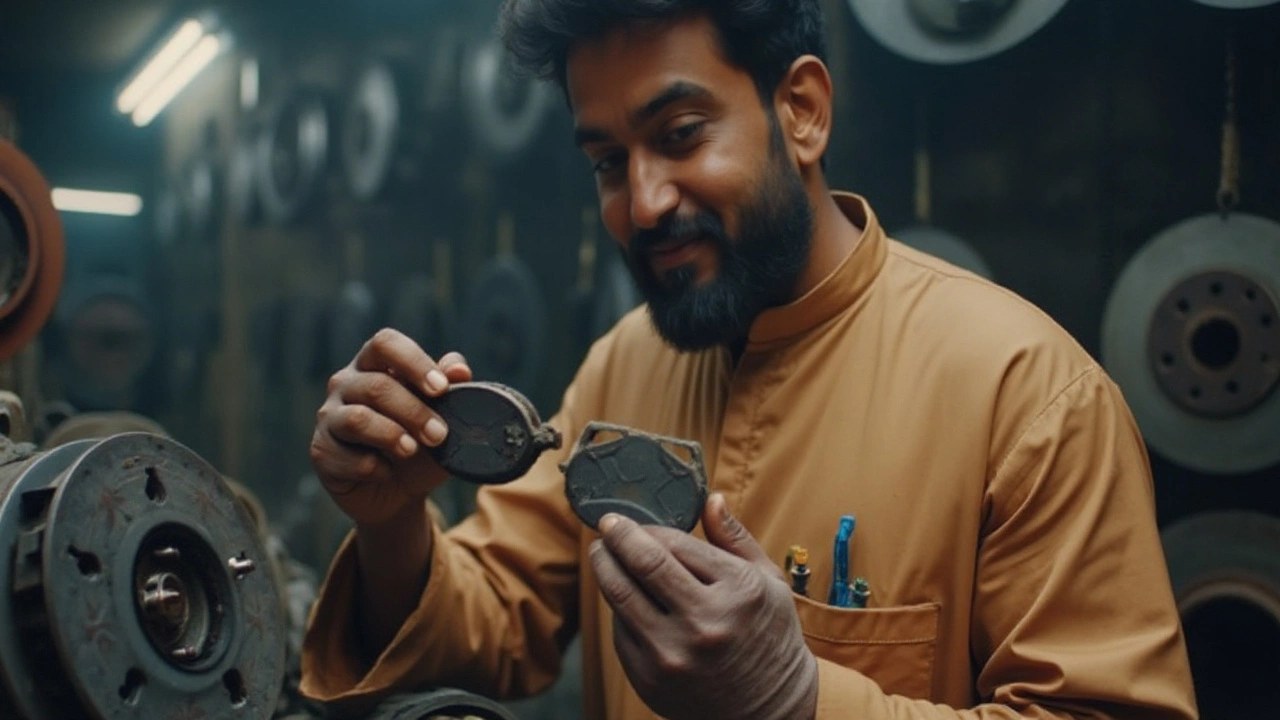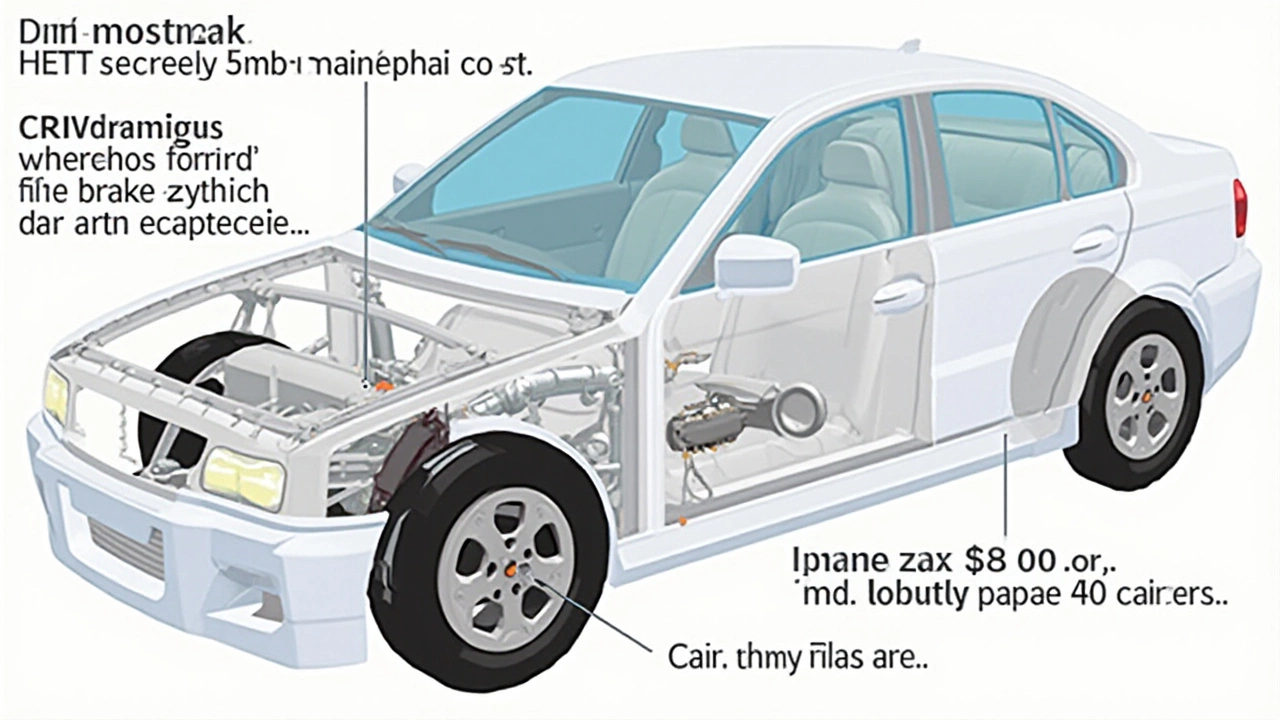Should You Replace All Four Brake Pads at the Same Time?
 Jan, 1 2025
Jan, 1 2025
Brake maintenance is a crucial aspect of vehicle upkeep that drivers often overlook until they hear that telltale screech. But when it's time to replace those worn-out pads, the question arises: should you change all four at the same time? It's an interesting dilemma that many drivers face.
Choosing whether to replace one pair or all four pads involves understanding how each axle operates and what a driver stands to gain or lose with either choice. With considerations like safety, cost, and long-term performance on the line, this decision bears weight.
This article delves into the intricacies of brake pad replacement, offering insights into how brake wear affects driving, the benefits of cohesive pad replacement, and practical advice for ensuring your vehicle's safety on the road. Let's explore the mechanical dance that is brake maintenance and the choices that can keep you and others safe.
- Understanding Brake Pad Mechanics
- Signs of Brake Pad Wear
- Benefits of Replacing All Pads at Once
- Cost Considerations
- Safety Implications
- Maintenance Tips for Longevity
Understanding Brake Pad Mechanics
At the heart of safe and effective vehicle performance is a component often overlooked until the last minute—brake pads. These are crucial elements nestled within the brake system that bear the task of halting your car with a reliable grip. To truly appreciate the significance of brake pads, one must recognize their primary role in creating friction against the rotor to slow down tire rotation. Crafted from materials like metallic, ceramic, or organic compounds, each type brings its unique attributes to the table. Brake pads are designed to dissipate heat efficiently while delivering consistent stopping power, a task easier said than done. As you hit the brake pedal, the hydraulic system engages the brake calipers, pressing the pads against the rotor. The friction generated is what eventually stops the vehicle. This intricate dance is a marvel of engineering, balancing kinetic and thermal forces to keep drivers safe. Understanding these dynamics can make a world of difference in vehicle maintenance routines.
Material Matters
The construction material of brake pads significantly influences their performance and longevity. Metallic pads, for instance, often cater to heavier vehicles due to their robust nature. They are cost-effective but can be noisier and wear down the rotors faster. Meanwhile, ceramic pads offer quieter operation and produce less dust, a trait highly sought after in passenger vehicles. However, they might not perform as well under extreme braking conditions compared to their metallic counterparts. Then there are organic pads, often made from a combination of fibers and resins; these are softer on the rotors but might need replacement more frequently. Given these differences, it's crucial for vehicle owners to align their brake pad choice with their driving needs and habits. Expert insights often emphasize the importance of considering load, terrain, and driving style when selecting the right brake pad material for your vehicle.
Engineers' Insight
“The art of balancing safety, performance, and cost in brake pad development is a continuous challenge,” remarks James K. Ivanildo, a renowned automotive engineer. This statement underlines the intricate considerations behind what might otherwise be perceived as a simple component.
Brake pads come in various thickness levels, impacting their replacement intervals. Pads wear down over time due to constant friction, and when they become too thin, it compromises their ability to function efficiently. A typical threshold for pad thickness replacement is around the 3mm mark. As they thin out, the ability to dissipate heat diminishes, risking brake fade—an issue where brakes lose effectiveness with constant use over time. Regular inspections, particularly before and after long trips, ensure that wear levels are monitored, maintaining optimum performance.
Impact on Vehicle Dynamics
It’s fascinating how brake pads influence vehicle dynamics beyond simply stopping the car. They impact handling, ride comfort, and even fuel efficiency. When brake pads are worn unevenly, the vehicle can pull to one side during braking, affecting the driver's control. Uneven wear may also cause vibrations and noise, disrupting the driving experience. Additionally, improper braking can increase fuel consumption due to increased rolling resistance. The interconnected nature of the braking system with other vehicle components means that brake pads play a quiet yet pivotal role behind the scenes. Ensuring proper maintenance of these pads not only enhances safety but also upholds the overall performance and value of the vehicle.
Signs of Brake Pad Wear
Brake pads are unsung heroes in the world of car maintenance, tirelessly working behind the scenes, often under high-pressure conditions to ensure your vehicle stops firmly and safely. Recognizing the signs that your brake pads need replacing is critical in preventing more severe problems down the road. The first indicator is often a squealing noise. This sound, produced by a small metal shim called an indicator, is meant to warn drivers that the pads have worn down to a dangerous level. If ignored, this sound can escalate to a harsh grinding noise, signaling that the pads have worn completely, allowing metal components to grind against each other, which can severely damage the brake rotor.
In addition to auditory cues, a driver might notice that the car takes longer to come to a complete stop than it once did. This increased stopping distance is a critical signal indicating that the brake pads have thinned out and can no longer provide adequate friction. Another observable effect is a vibration or pulsation in the brake pedal or steering wheel when applying the brakes. This sensation could indicate unevenly worn pads or a warped rotor, both of which reduce braking efficiency and could affect vehicle safety. Furthermore, it’s essential to keep an eye on the vehicle’s brake warning lights. Modern cars are equipped with sensors that alert you when the brake system demands attention.
Visual inspections can also reveal much about brake health. A simple look through the wheel can sometimes provide a clear view of the brake pad against the rotor. Generally, if the pad is less than a quarter of an inch thick, it's time for a replacement. Additionally, noticing uneven wear across the pads or grooves etched into the brake rotor are red flags that issues need addressing promptly. According to the Automobile Association of America, "Regular inspections and early detection can save drivers from costly repairs and ensure safe driving conditions."
Engaging in proactive maintenance is not only about preventing unpleasant surprises but also about preserving the vehicle’s longevity. Interestingly, vehicle safety largely depends on how well a driver can detect and respond to these early warning signals. As a preventive measure, having brake pads inspected during regular oil changes can help. This habit ensures that your vehicle remains in optimal condition, minimizing the chance of unexpected brake failure. It costs far less to maintain brake health than to address catastrophic failures that could compromise driver and passenger safety. For those mindful of car maintenance, learning about these signs is an important step in becoming a responsible vehicle owner.

Benefits of Replacing All Pads at Once
When it comes to vehicle safety, keeping your brakes in top condition is paramount. Choosing to replace all four brake pads simultaneously can offer a variety of impressive benefits, not only in terms of performance but safety and economics as well. Many drivers don't realize that replacing all pads at once can help maintain a balanced braking system. A balanced system ensures that during a sudden stop, your vehicle halts smoothly without veering to the side which can happen if there's uneven wear across your brake pads.
Equal wear provides an even distribution of force across all wheels, allowing for a consistent stopping power which, in turn, may prevent potential accidents. Moreover, driving with evenly worn pads can improve the lifespan of your rotors, as it reduces the chances of rotor warping that occurs due to uneven pad pressure. This might save you from more costly rotor replacements down the line, which any car owner will agree is a boon.
"Replacing all brake pads at the same time can significantly reduce repair costs and increase your vehicle's safety." - Auto Insight Mechanics
Economically speaking, replacing all brake pads at the same time can indeed be more cost-effective. While it might seem initially expensive, service packages often provide a better per-piece price when updating everything in one go. It's akin to the buy-in-bulk philosophy where you'll be spending less per item. This proactive approach potentially avoids more frequent visits to your mechanic, saving not just dollars, but also valuable time in the long run.
Enhanced Brake Performance
One of the most notable benefits is a noticeable improvement in brake performance. With consistently new brake pads, drivers often experience a shorter stopping distance under normal driving conditions. It’s a reassuring feeling to know that when you press the brake pedal, your car will respond promptly, reducing stress and enhancing driving confidence. Brake replacement isn't just about swapping old for new; it's about upgrading the system's integrity and ensuring that all components work in perfect harmony.
In this regard, keeping a consistent maintenance schedule is essential. Habits like regular checks and listening for those unusual screeches and squeaks can help determine the right moment for a complete brake pad overhaul. Such diligence not only ensures safety but also maximizes the benefits of replacing all pads at once, allowing drivers to enjoy the peace of mind that comes with knowing their vehicle is in optimal condition.
Cost Considerations
When it comes to replacing brake pads, one of the foremost concerns for many vehicle owners revolves around costs. These costs can vary significantly depending on whether you decide to replace one set of pads or all four at once. Let's break this down to provide a clear understanding of what affects these costs and how you might plan accordingly. On a per-unit basis, replacing each individual set of pads might appear less expensive initially, but this isn’t always the full picture.
Typically, replacing all four brake pads simultaneously can lead to significant savings in labor costs. Many garages charge by the hour or job, meaning a single comprehensive visit to tackle all brake pads can be cheaper than separate visits for the front and rear pads. This becomes especially true when you consider the allied costs involved, such as the fees for inspections or the resetting of braking systems that are sometimes required when pads are changed piecemeal. Mechanics often offer bundle deals for a full replacement, which may reduce the per-set cost.
While up-front costs might seem higher, it’s important to factor in the long-term implications. Continuously replacing pads at different intervals might lead to uneven wear and tear on the vehicle’s braking system. This can result in additional damage to other brake components like rotors or calipers, ultimately leading to more expensive repairs. In the longer run, preventing uneven wear through simultaneous replacements may save money by maintaining balanced system performance, potentially reducing the need for premature replacements of other costly brake parts.
Financial Planning and Maintenance Tips
Planning brake replacements can also help in budgeting expenses. By anticipating when both front and rear pads will need replacing, you can set aside funds specifically for this maintenance task, minimizing the financial impact of unexpected car repairs. Given that brake pads typically need replacement every 30,000 to 70,000 miles depending on driving conditions and habits, predicting this with regular check-ups can also prevent financial surprises.
A study reflecting consumer behavior revealed that nearly 40% of car owners regret not planning substantial maintenance tasks financially, leading to financial strain when unplanned repairs arise. Aligning brake replacements with other scheduled maintenance activities can also help optimize both time and costs. Some car owners have reported that bundling services leads to as much as a 15% reduction in total maintenance costs annually.
In the end, deciding whether to replace all brake pads at once centers around a balance between immediate out-of-pocket expense and long-term savings and safety. While the decision remains yours, the potential cost-effectiveness and peace of mind from replacing all four brake pads might just make it worthwhile.

Safety Implications
When it comes to maintaining your vehicle, safety is paramount, and your brake pads are at the heart of this concern. Replacing all four brake pads might seem excessive, but there are compelling safety reasons to consider this approach. Balanced brake performance is vital for maintaining control during sudden stops, especially in adverse conditions. When all four pads are of the same age and condition, they provide consistent braking force, reducing the risk of the vehicle pulling to one side or experiencing uneven wear that can compromise handling.
A mismatched set of brake pads, where the front and rear or left and right pads are of different ages or wear patterns, can lead to inconsistent braking. This disparity can be a silent hazard until a sudden stop requires perfect performance. Even more, the uneven stress on your braking system can accelerate wear on other components, leading to costlier repairs down the line and increased risks during emergency maneuvers. As the National Highway Traffic Safety Administration notes, "Braking is a force that the driver should be able to rely on without thinking twice."
It's not just about wear patterns. The materials in your brake pads also play a role in brake efficiency. Variability in pad material between old and new sets can alter how the brakes respond. Most drivers aren't aware that the friction coefficient in their pads could have deteriorated over time. Replacing all four ensures you have uniform material properties throughout. Additionally, this uniformity helps with heat distribution across the braking system, preventing phenomena like brake fade, especially on long downhill drives or under heavy braking conditions.
There's also the psychological safety factor to consider. Knowing that your car is leveraging full, balanced braking capability can make a significant difference in your driving confidence, especially in traffic-heavy urban environments or on highways. Understanding the link between vehicle safety and maintenance doesn't just empower you as a driver; it ensures that every ride you take is as risk-free as possible. When you consider the safety of those around you—passengers and pedestrians included—those extra pads seem like a small price to pay for peace of mind.
Maintenance Tips for Longevity
When it comes to ensuring your vehicle's brake pads last the distance, understanding proper maintenance can really make a difference. Regular inspections are a fundamental pillar in the longevity of brake components. Start by checking your brakes at least twice yearly, or as part of routine service checks. Look for signs like visible wear, uneven pad surface, or any squealing sounds. These can be subtle signs pointing towards the need for attention. Good brake health isn't just about the brake pads—it's also about the rotors, calipers, and the entire system. Ensuring these components are in optimal shape is crucial, and can prevent unnecessary wear that diminishes pad life. Be attentive to any unusual vibrations through the steering wheel, as this could indicate an uneven contact surface.
Driving habits play an integral role in maintaining brake longevity. Gentle braking not only ensures a smoother ride but also extends the life of your brake pads. Consistent hard stopping, especially when unnecessary, adds a burden on the brakes. Modern vehicles might demonstrate great stopping power, but with that comes the responsibility of mindful driving habits. Consider driving with a proactive mindset, anticipating stops, and braking gradually. Engaging in mindful driving habits not only spares the brake system but also contributes to better fuel efficiency, combining vehicle longevity with economic benefits.
Choice of materials and parts is another pivotal factor. When it's time for replacement, opting for high-quality brake pads can result in prolonged lifespan and improved performance. Nowadays, there are various materials available, from ceramic to semi-metallic pads. Each offers unique benefits. Ceramic pads are known for quieter operation and longer wear, albeit at a higher price. In contrast, semi-metallic pads may be more cost-effective but can be noisier. Find the right balance that suits your driving needs and budget to achieve the best results.
“One ounce of prevention is worth a pound of cure.” This old saying rings especially true when it comes to vehicle maintenance.Embracing a preventative mindset can save substantial costs and avoid unforeseen wear and tear. Stay ahead of potential issues with timely replacements and adjustments. It's worth noting that overheating your brakes can also accelerate wear. Allow your brakes some time to cool down after significant use, particularly after any intense braking activities.
Lastly, do not underestimate the power of professional advice. Regular consultations with a skilled technician can unearth potential issues you might overlook during a do-it-yourself inspection. Experienced technicians possess the know-how to diagnose intricate issues and provide expert guidance tailored to your vehicle's specific needs. Investing in professional inspection, at least annually, might initially seem like an added expense, but it ensures the delicate brake ecosystem remains uncompromised. Seek trusted workshops or dealerships, ensuring they possess a strong track record in brake maintenance.